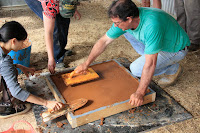 |
| Wall (and pic) by Milkwood |
In some ways, it was like taking a short trip - to a place I'd never been before, but had long been curious about. I got to meet new people, fill my notebook with interesting things, take a few pics and drop into a new culture, guided by natural building guru (and incredible teacher) Sam Vivers, of Viva Homes, which designs and builds strawbale houses.
 |
| Sam Vivers, our natural building leader |
Real sustainable homes, he says, not only use less carbon than man-made processed materials, they have incredible properties such as the ability to regulate temperature and purify the air inside. They're healthy to live in, and healthy for those building them.
And it's on the rise. "Fifteen years ago when we built our first strawbale house, no one knew what it was," says Sam. "Now [thanks largely to Grand Designs and its eco-conscious presenter Kevin McCloud], everyone's asking not 'what is it?' but 'how do they work, and how do you build them?'"
 |
| Mixing up light straw (clay with straw) |
There were 24 of us, including an apprentice carpenter, an architect, a few builders, a natural gardener. Then there were those who, like me, are a bit in love with cabins and tiny houses and dream of building their own one day.
As the rain drummed on the corrugated roof of our giant shed-classroom, for the first three days at least, we learned about thermal mass and passive solar design, how to choose a building site, and about various roof designs, floor systems and natural materials - strawbale is the most common but there's also cob (clay), rammed earth, mud bricks, recycled timber, earthbags, hempcrete.
We talked in millimetres and R-values (insulation ratings), learned how not to build a "gingerbread house" (builder-ese for a house that's not plumb or level).
 |
| How many rookies does it take to build a straw wall? |
 |
| Getting my hands dirty Pic: Carmel Killin |
The next day we smeared an earth render all over the straw with our bare, muddy hands. Later in the week, we gave it smoother coats, and put a lime render on the "outside" - for weatherproofing.
We made a cob wall - by ramming clumps of clay with bits of straw in it, inside a plywood frame; it was hard work (note to self: never build with rammed earth). And a "reciprocal roof" out of bamboo poles that radiated at tangents from a central, chimney-like hole. On our last day we even made a (one square metre) earth floor.
 |
| A tiny earth floor |
1. Natural building is a community thing. It’s great to be involved in building even part of your own home, and Sam recommends it, but you need help. “Modern building materials are designed to reduce labour costs,” he says, because labour is expensive in Australia. So people building natural homes often run workshops: you get to learn and practise skills you might use on your own place, they get volunteer labour.
2. Straw is not hay! You might be wondering what the difference is (as I did, out loud, on day one.) I learned that although they look similar, straw is a byproduct of rice farming (in NSW; wheat straw is often used in Queensland). It's the stems of the harvested plants. Hay is grass, usually lucerne used for animal feed, and unsuitable for building; its high moisture content means the bales can go mouldy.
3. Natural houses are good for us, and the planet. They're non-toxic (asthmatics often breathe easier in natural homes) and comfortable to live in (warm in winter, cool in summer, and earth floors are softer to walk on than concrete slabs). Straw in particular is one of the best insulators in the world. Natural homes also last, as anything sustainable must, and when a house does eventually reach the end of its life, everything it's made from can return to the earth.
 |
| A strawbale home in all its glory |
5. Different materials suit different conditions/locations. Mud brick works best when there’s a big diurnal range in temperature, e.g. hot days and cold nights. "Earth ships" work well in hot climates because they rely on the thermal mass of the earth (did you know that in Australia the temperature two metres underground is a constant 16C?). Recycled timber is cheap, but labour intensive (to pull out old nails, etc). The material or method you choose largely depends on what's available on your site or nearby.
 |
| Our work is done: a sun-break on our last day |
*No cabin was actually built in the course of this course. But having never made anything bigger than a ceramic pot, I'm excited just to have inched - or millimetred - a little closer to the idea of building one, one day.
Milkwood's next Natural Building Course is 19-22 November 2015, in Kangaroo Valley, NSW. For more information about natural building and strawbale houses in particular, see vivahomes.com.au and the FAQ page.
No comments:
Post a Comment